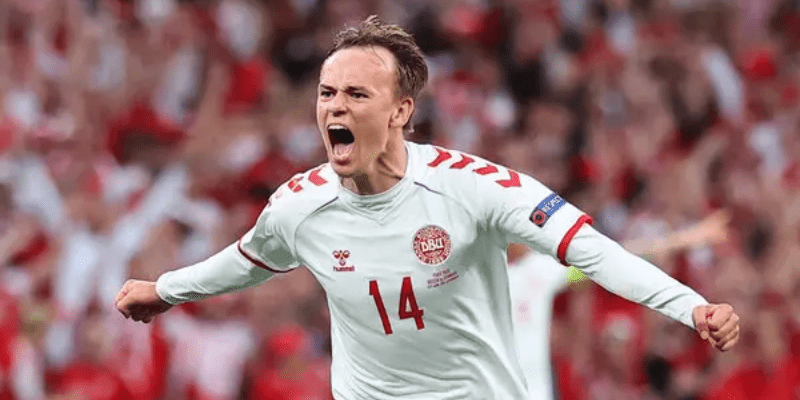Denmark may not always dominate global headlines like Brazil or Germany, but the Danish national team has produced some truly lethal forwards across eras. From early 20th-century goal machines to modern poachers, the story of Danish strikers is one of ingenuity, grit, and finishing flair. In this article, CantoKick will take you on a journey through the greatest Danish marksmen ever to wear the red and white, highlighting their records, style, and moments of glory.
Why These Strikers Matter

Before diving into the list, it’s worth asking: what makes a striker legendary? For Danish football, the bar is high. The top forwards didn’t just score—they shifted perception, inspired teams, and produced iconic moments in major tournaments. Because the best Denmark strikers of all time must combine goal tallies with influence, clutch goals, consistency, and a sense of identity tied to Danish football.
Statistically, Denmark’s all-time scoring charts offer a strong starting point., Poul “Tist” Nielsen and Jon Dahl Tomasson share the national team record with 52 goals each. Behind them, names like Preben Elkjær, Pauli Jørgensen, Ole Madsen, and Michael Laudrup appear among top scorers.
But raw numbers only tell part of the tale. Below, CantoKick ranks seven strikers who combine statistics with historical weight, character, and iconic moments for national and club football.
1. Poul “Tist” Nielsen (1910–1925)
Poul Nielsen is a pillar of Danish football lore. In just 38 caps, he scored 52 goals—a phenomenal strike-rate that remains unmatched in Denmark’s national history. ball])
- Though he played before World Cup football took off, Nielsen starred in the Olympics and dominated Scandinavian cups and friendlies.
- His scoring feats include eight hat-tricks—and once, four goals in a single game against Germany in 1913.
- At club level, he built his reputation with Kjøbenhavns Boldklub, winning multiple Danish titles.
Nielsen’s mark on Danish football is foundational: he sets the benchmark for everything that came after.
2. Jon Dahl Tomasson (1997–2010)
If there’s one modern-era Dane whose name rivals Nielsen’s, it’s Jon Dahl Tomasson. He matched Nielsen with 52 goals, but in 112 caps, making him Denmark’s all-time joint top scorer. u Football])
- His club career was stellar: Feyenoord, AC Milan, Villarreal—Tomasson shone in the Netherlands, Italy, and Spain.
- Known for intelligent movement, poacher’s instincts, and technical quality, he adapted his game across systems—sometimes leading the line, sometimes playing in tandem.
- In major tournaments, he delivered. He featured at Euros 2000 & 2004, and the 2002 & 2010 World Cups.
- Off the pitch, his leadership and longevity make him a model pro for younger Danish attackers.
Tomasson’s legacy is one of continuity: bridging Denmark’s old guard and the modern era, and holding records with style.
3. Preben Elkjær (1977–1988)
While Elkjær’s 38 goals in 69 caps may not top the scoring charts, his status among fans and peers is immense.
- He was the attacking spearhead of the famed “Danish Dynamite” era in the 1980s, playing with fire, flair—and occasional recklessness.
- In Euro 1984, he struck two goals and helped Denmark reach the semifinal, and in the 1986 World Cup he scored a hat-trick vs Uruguay, earning the Bronze Ball as third best player of the tournament.
- At club level, his time at Hellas Verona in Serie A was notable—helping them to one of their greatest seasons.
- His characteristic fighting spirit and flair made him a beloved national hero.
Elkjær embodies the spirit of Danish football in its breakthrough era—passionate, charismatic, and able to turn games single-handedly.
4. Pauli Jørgensen (1925–1939)
Though playing in an earlier age, Pauli Jørgensen left a massive mark. He tallied 44 goals in 47 caps—a remarkable ratio in his era.
- He was a consistent scoring presence in the 1920s–1930s, often dominating Scandinavia’s regional tournaments.
- He is less remembered than Nielsen today, but in the context of pre-World War II football, his consistency and scoring power made him one of the leading Danish strikers.
- His physical play and positional sense suited the rougher style of early football.
Jørgensen is a reminder that Denmark’s goalscoring pedigree didn’t begin with Nielsen—it was already developing in the interwar years.
5. Ole Madsen (1958–1969)
Ole Madsen scored 42 goals in 50 matches, making him one of Denmark’s most efficient modern-era forwards.
- He played in an era when Denmark wasn’t a regular at world tournaments, but Madsen’s exploits garnered attention across Europe.
- Known for his aerial ability, physical presence, and powerful finishing, he regularly terrorized defenses in Nordic and European friendlies.
- His legacy is that of a link between old-style strikers and the modern technical forwards Denmark would later produce.
Madsen remains a benchmark for mid-20th century Danish attacking talent.
6. Michael Laudrup
Though not a classic centre-forward, Michael Laudrup deserves inclusion because of his forward versatility and influence in attack. He scored 37 goals for Denmark in 104 appearances.
- Laudrup’s playmaking, vision, and attacking intelligence turned him into one of Denmark’s greatest ever players.
- In his club career, he played in advanced roles and often behaved like a second striker or false-nine.
- While he lacks the goal volume of some pure strikers, his impact in transition, assists, and linking play expanded what a “striker” could mean in Danish football.
- His technical elegance and positional freedom make him a bridge figure between midfield playmakers and attacking strikers.
Laudrup is proof that greatness comes in many attacking shapes—not just pure goal scorers.
7. Nicklas Bendtner (2006–2018)
While more controversial than canonical, Nicklas Bendtner still merits a spot as a modern-era forward with impact. He scored 30 goals in 81 caps.
- Bendtner’s prime years aligned with his time at Arsenal, Sunderland, and other European clubs. He offered a mix of aerial threat and physical play.
- His national team contributions included important goals in qualifying campaigns, and he carried the weight of national expectations at times.
- Although consistency and injuries limited his full potential, his presence and occasional brilliance ensure he remains in conversations.
Bendtner stands as a reminder that even imperfect stars can shine—he is a modern point of reference and cautionary tale in one.
Honorable Mentions

- Henning Enoksen: Scored 29 goals in 54 caps, active in the late 1950s to 1960s.
- Ebbe Sand: Scored 22 goals in 66 caps, a consistent performer around the turn of the 21st century.
- Yussuf Poulsen: Among active Danish forwards, he has delivered some clutch goals though his total (14 in 86 caps) is modest for a historical list.
Comparison and Legacy

It’s illuminating to compare:
| Player | Caps | Goals | Goals per Game | Era / Notes |
| Poul Nielsen | 38 | 52 | 1.37 | Early 1900s — record scorer |
| Jon Dahl Tomasson | 112 | 52 | 0.46 | Modern era, matched Nielsen |
| Preben Elkjær | 69 | 38 | 0.55 | Symbol of 80s attacking force |
| Pauli Jørgensen | 47 | 44 | 0.94 | Interwar era, high rate |
| Ole Madsen | 50 | 42 | 0.84 | Mid-20th century stalwart |
| Michael Laudrup | 104 | 37 | 0.36 | Creative forward / hybrid role |
| Nicklas Bendtner | 81 | 30 | 0.37 | High potential, mixed outcomes |
Those figures underscore just how extraordinary Nielsen’s scoring rate was, and how Tomasson rewrote the narrative in modern terms.
Beyond numbers, the best Denmark strikers of all time share other traits:
- Clutch impact: Elkjær’s hat-trick in the World Cup, Tomasson’s tournament goals, Laudrup’s movement in big fixtures.
- Versatility: Many adapted across systems and roles, rather than being one-dimensional.
- Cultural resonance: Elkjær sparked national pride; Tomasson became a symbol of Denmark’s modern football; Nielsen remains mythic.
Denmark’s striker heritage is rich and layered—even if the country hasn’t always been the first considered among footballing superpowers.
Final Thoughts
In exploring the best Denmark strikers of all time, we’ve crossed eras: from the foundational genius of Poul “Tist” Nielsen, to the modern adaptability of Jon Dahl Tomasson and the ferocity of Preben Elkjær. These players did more than score—they defined how Denmark attacks, inspires, and dreams.
For Danish football fans and global aspirants alike, the lessons are clear: brilliance can come in bursts or longevity, flamboyance or stealth—but the love for the goal ties them all.
If you’re a fan wanting dee, or a “top 10 Danish strikers by club performance,” CantoKick is ready to deliver. Join us, revisit these legends, and push the conversation: who will be the next name to enter this elite list?



